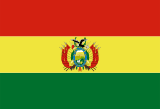Electoral system for national legislature

Bolivia
Bolivia, Constitution 2009, accessed 20 October 2020
Article 146
I. The Chamber of Deputies shall have 130 members.
II. In each Department, half of the Deputies (Diputados) shall be elected by direct voting electoral districts. The other half shall be elected by proportional voting electoral districts, from lists headed by candidates for President, Vice President and the Senators of the Republic.
III. Deputies are elected by universal, direct and secret vote. In the single Districts, they are elected by simply majority of the voters; in the multiple districts, by a system of representation established by law.
IV. The number of Deputies must reflect the proportional vote obtained by each party, citizen group or indigenous people.
V. The total distribution of seats among the departments shall be determined by the Electoral Organ (Organo Electoral) on the basis of the number of inhabitants in each one of them, pursuant to the latest National Census, according to law. For equity, the law shall assign a minimum number of seats to the departments that have the least population and least economic development. If the distribution of seats for any department is an uneven number, preference will be given to the single districts for the assignment of the seats.
VI. The single districts must have geographical continuity, affinity and territorial continuity; they may not extend beyond the borders of each department and must be based on criteria of population and territorial extension. The Electoral Organ shall define the single districts.
VII. The special rural native indigenous districts shall be governed by the principle of density of population in each department. They shall not cross department borders. They shall be established only in a rural area in those departments in which those nations and native indigenous rural peoples constitute a minority population. The Electoral Organ shall define the special districts. These districts form part of the total number of deputies.
Bolivia, Law 026 of 30 June 2010, as amended by Law 421 of 7 October 2013, accessed 20 October 2020
ARTICLE 50. (ELECTORAL CIRCUNSCRIPTIONS). For the purpose of electing authorities and representatives at the national, departmental, regional, municipal and rural native indigenous autonomies, the following electoral districts are established:
I. For the election of national authorities and representatives:
a) A national constituency, which includes the electoral seats located abroad, for President or President and Vice President or Vice President of the Plurinational State.
b) Nine (9) departmental constituencies for Senators and Senators.
c) Nine (9) departmental constituencies for multi-member Deputies and Deputies.
d) Uninominal constituencies for deputies and uninominal deputies, defined by Law.
e) Special constituencies for peasant native indigenous deputies, defined by law. […]
[Paragraph I, subparagraphs d) and e) of Article 50 was modified by Article 1 of Law No. 421 “Law on the Distribution of Seats among Departments” of October 7, 2013.]
For the details of the electoral system refer to the articles 56-61.
FPTP for 63 members, FPTP for Indigenous 7 members, and List PR for 60 members. List PR using closed list and d’Hondt method.